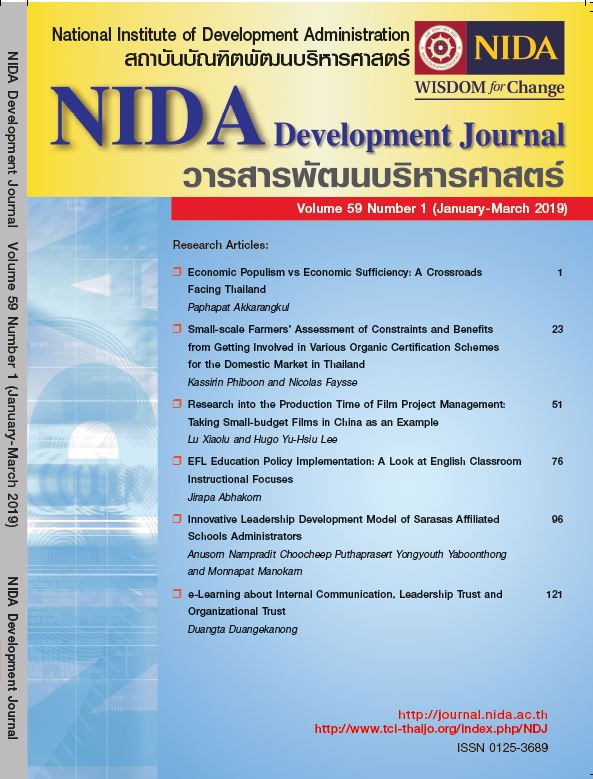E-Learning about Internal Communication, Leadership Trust and Organizational Trust
Main Article Content
Abstract
This research reports on the effects of an organizational e-learning intervention to improve internal communication on leadership trust and organizational trust. The research is a case study of a Thai furniture manufacturing firm, in which formal internal communication processes are being developed to improve organizational performance. The research proposes a multi-stage model, with six system characteristics (user interface, learning community, system content, system operation, personalization, and expectance confirmation) influencing user satisfaction with the e-learning system; user satisfaction was then proposed as influencing leadership trust, which in turn influenced organizational trust. The study is analyzed using structural equation modelling (SEM). Five of six system characteristics do have a significant influence on user satisfaction; user satisfaction did influence leadership trust, which in turn influence organizational trust as proposed. The implication of this study is that using e-learning to train employees on key processes like internal communication can improve leadership and organizational trust.
Article Details
References
Avolio, B. J., Sosik, J. J., Kahai, S. S., & Baker, B. (2014). E-leadership: Re-examining transformations in leadership source and transmission. The Leadership Quarterly, 25, 105-131.
Bhuasiri, W., Xaymoungkhoun, O., Zo, H., Rho, J. J., & Ciganek, A. P. (2012). Critical success factors for e-learning in developing countries: A comparative analysis between ICT experts and faculty. Computers and Education, 58, 843-855.
Clark, R. C., & Mayer, R. E. (2016). E-learning and the science of instruction: Proven guidelines for consumers and designers of multimedia learning (4th ed.). Hoboken, NJ: John Wiley and Sons.
Cornelissen, J. (2004). Corporate communications theory and practice. Thousand Oaks, CA: Sage Publications.
Douglas, C., & Zivnuska, S. (2008). Developng trust in leaders: An antecedent of firm performance. S.A.M. Advanced Management Journal, 73(1), 20-28.
Fulmer, C. A., & Gelfand, M. J. (2012). At what level (and in whom) do we trust: Trust across multiple organizational levels. Journal of Management, 38(4), 1167-1230.
Holsapple, C. W., & Lee-Post, A. (2006). Defining, assessing, and promoting e-learning success: An information systems perspective. Decision Sciences Journal of Innovative Education, 4(1), 67-85.
Kramer, R. M., & Lewicki, R. J. (2010). Repairing and enhancing trust: Approaches to reducing organizational trust deficits. Academy of Management Annals, 4(1), 245-277.
Lee, M. -C. (2010). Explaining and predicting users’ continuance intention toward e-learning: An extension of the expectation–confirmation model. Computers and Education, 54, 506-516.
Mazzei, A. (2010). Promoting active communication behaviours through internal communication. Corporate Communications: An International Journal, 15(3), 221-234.
Mazzei, A. (2014). A multidisciplinary approach for a new understanding of corporate communication. Corporate Communication: An International Journal, 19(2), 216-230.
Miller, K. (2015). Organizational communication: Approaches and processes (2nd ed.). Stamford, CT, USA: Cengage Learning.
Pirson, M., & Malhotra, D. (2011). Foundations of organizational trust: What matters to different stakeholders? Organization Science, 22(4), 1087-1104.
Sangrá, A., Vlachopoulos, D., & Cabrera, N. (2012). Building an inclusive definition of e-learning: An approach to the conceptual framework. The International Review of Research in Open and Distributed Learning, 13(2), 145-159.
Schoorman, F. D., Mayer, R. C., & Davis, J. H. (2007). An integrative model of organizational trust: Past, present and future. Academy of Management Review, 32(2), 344-354.
Shee, D. Y., & Wang, Y. -S. (2008). Multi-criteria evaluation of the web-based e-learning system: A methodology based on learner satisfaction and its applications. Computers and Education, 50(3), 894-905.
Siritongthaworn, S., & Krairit, D. (2006). Satisfaction in e‐learning: the context of supplementary instruction . Campus-Wide Information Systems, 23(2), 76-91.
Sun, P. -C., Tsai, R. J., Finger, G., Chen, Y. -Y., & Yeh, D. (2008). What drives a successful e-Learning? An empirical investigation of the critical factors influencing learner satisfaction. Computers and Education, 50(4), 1183-1202.
Verčič, A. T., Verčič, D., & Srirahmesh, K. (2012). Internal communication: Definition, parameters and the future. Public Relations Review, 38, 223-230.
Venkatesh, V., & Davis, F. D. (2000). A theoretical extension of the technology acceptance model: Four longitudinal field studies. Management Science, 46, 186–204.
Wang, Y. -S. (2003). Assessment of learner satisfaction with asynchronous electronic learning systems. Information and Management, 41(1), 75-86.
Wang, Y. -S., Wang, H. -Y., & Shee, D. Y. (2007). Measuring e-learning systems success in an organizational context: Scale development and validation. Computers in Human Behavior, 23, 1792-1808.
Welch, M., & Jackson, P. R. (2007). Rethinking internal communication: A stakeholder approach. Corporate Communications: An International Journal, 12(2), 177-198.
Yang, J., & Mossholder, K. W. (2010). Examining the effects of trust in leaders: A bases-and-foci approach. The Leadership Quarterly, 21(1), 50-63.

